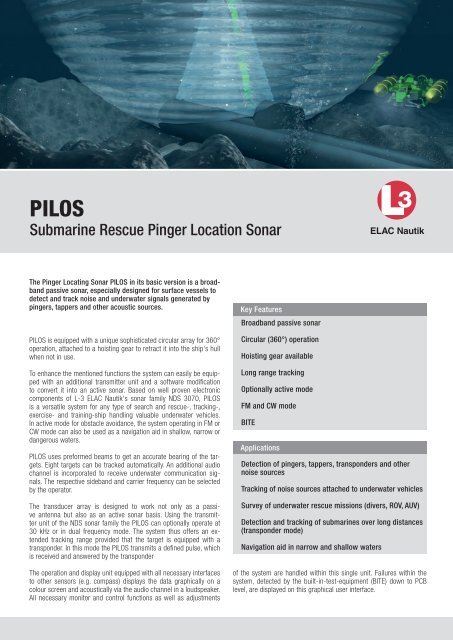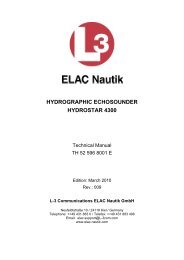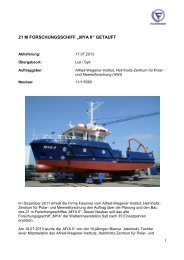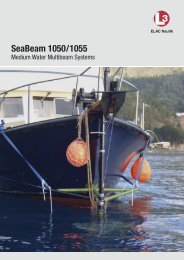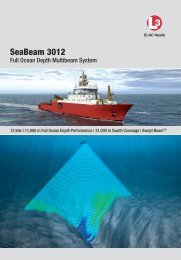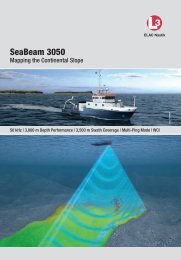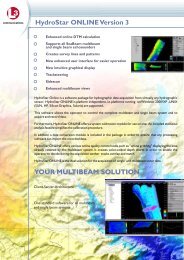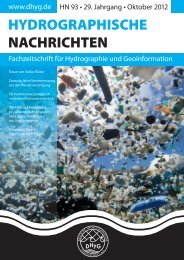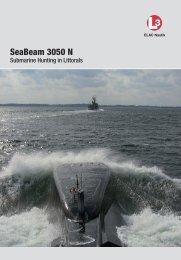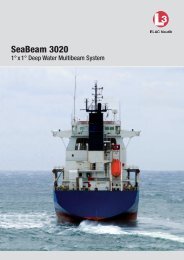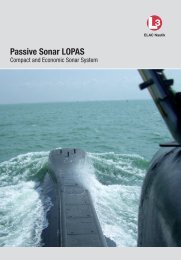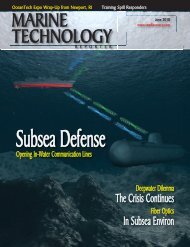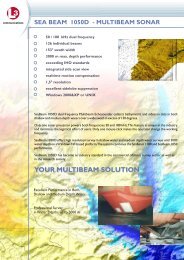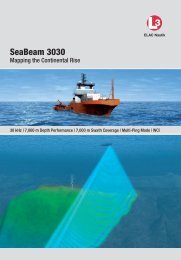Submarine Rescue Pinger Location Sonar - Elac-Nautik
Submarine Rescue Pinger Location Sonar - Elac-Nautik
Submarine Rescue Pinger Location Sonar - Elac-Nautik
You also want an ePaper? Increase the reach of your titles
YUMPU automatically turns print PDFs into web optimized ePapers that Google loves.
PILOS<br />
<strong>Submarine</strong> <strong>Rescue</strong> <strong>Pinger</strong> <strong>Location</strong> <strong>Sonar</strong><br />
The <strong>Pinger</strong> Locating <strong>Sonar</strong> PILOS in its basic version is a broadband<br />
passive sonar, especially designed for surface vessels to<br />
detect and track noise and underwater signals generated by<br />
pingers, tappers and other acoustic sources.<br />
PILOS is equipped with a unique sophisticated circular array for 360°<br />
operation, attached to a hoisting gear to retract it into the ship's hull<br />
when not in use.<br />
To enhance the mentioned functions the system can easily be equipped<br />
with an additional transmitter unit and a software modifi cation<br />
to convert it into an active sonar. Based on well proven electronic<br />
components of L-3 ELAC <strong>Nautik</strong>'s sonar family NDS 3070, PILOS<br />
is a versatile system for any type of search and rescue-, tracking-,<br />
exercise- and training-ship handling valuable underwater vehicles.<br />
In active mode for obstacle avoidance, the system operating in FM or<br />
CW mode can also be used as a navigation aid in shallow, narrow or<br />
dangerous waters.<br />
PILOS uses preformed beams to get an accurate bearing of the targets.<br />
Eight targets can be tracked automatically. An additional audio<br />
channel is incorporated to receive underwater communication signals.<br />
The respective sideband and carrier frequency can be selected<br />
by the operator.<br />
The transducer array is designed to work not only as a passive<br />
antenna but also as an active sonar basis. Using the transmitter<br />
unit of the NDS sonar family the PILOS can optionally operate at<br />
30 kHz or in dual frequency mode. The system thus offers an extended<br />
tracking range provided that the target is equipped with a<br />
transponder. In this mode the PILOS transmits a defi ned pulse, which<br />
is received and answered by the transponder<br />
The operation and display unit equipped with all necessary interfaces<br />
to other sensors (e.g. compass) displays the data graphically on a<br />
colour screen and acoustically via the audio channel in a loudspeaker.<br />
All necessary monitor and control functions as well as adjustments<br />
Key Features<br />
Broadband passive sonar<br />
Circular (360°) operation<br />
Hoisting gear available<br />
Long range tracking<br />
Optionally active mode<br />
FM and CW mode<br />
BITE<br />
Applications<br />
Detection of pingers, tappers, transponders and other<br />
noise sources<br />
Tracking of noise sources attached to underwater vehicles<br />
Survey of underwater rescue missions (divers, ROV, AUV)<br />
Detection and tracking of submarines over long distances<br />
(transponder mode)<br />
Navigation aid in narrow and shallow waters<br />
of the system are handled within this single unit. Failures within the<br />
system, detected by the built-in-test-equipment (BITE) down to PCB<br />
level, are displayed on this graphical user interface.
DISCOVER THE UNKNOWN<br />
Specifications and Technical Data<br />
PILOS at a Glance<br />
Technical Data<br />
Passive frequency range<br />
1.0 to 50 kHz<br />
Receive sector 360°<br />
ATT channels<br />
Bearing accuracy<br />
Frequency analysis<br />
Frequency analysis for pre-formed beams<br />
History display for<br />
Optional active mode<br />
Pulse lengths:<br />
Source level at 30 kHz (RDT)<br />
Source level at 30 kHz (ODT)<br />
Transmission sector<br />
Power reduction<br />
Scale ranges<br />
Audio channel<br />
Power supply<br />
Voltage tolerance<br />
Power consumption<br />
Power supply for anti-condensation heating<br />
Power consumption<br />
MTBF<br />
MTTR<br />
Operation temperature range<br />
Storage temperature range<br />
Operational pressure wetends<br />
8<br />
2.0°<br />
1.0 to 50 kHz with 100 Hz resolution<br />
1.0 to 50 kHz with 100 Hz resolution<br />
10, 30 or 60 minutes<br />
30 kHz (CW and FM)<br />
0.2, 2, 10 or 20 ms<br />
226 ± 3 dB rel. 1 Pa, 1 m (array only)<br />
214 ± 3 dB rel. 1 Pa, 1 m (array only)<br />
60° to 360° (selectable in steps of 60°)<br />
10 and 20 dB<br />
100, 500, 1000, 2000, 4000 and 10000 m<br />
(15000 m for transponder mode)<br />
1 to 12 kHz<br />
115V, 50/60 Hz, single phase<br />
10%<br />
approx. 800 VA<br />
115V, 50/60 Hz, single phase<br />
approx. 50 VA<br />
1800 hours<br />
30 minutes (excluding wetends)<br />
0° to +45°C<br />
-35° to +70°C<br />
0.3 MPa<br />
EMC according to EN 55022, 08/94,<br />
Corrosion resistance resp. EN 50082.2, 03/95<br />
according to DEF-STAN 7-55, 7/75<br />
Transmitter unit LGN 19, hoisting gear LAG 37 and<br />
cylindrical array WB 40<br />
L-3 Communications ELAC <strong>Nautik</strong> GmbH | Neufeldtstrasse 10 | 24118 Kiel | Germany | Tel. +49 (0)431-883 0 | Fax +49 (0)431-883 496<br />
elac.marketing@L-3com.com | www.elac-nautik.de | Design changes and errors reserved. Rev. B 14/11/2013


